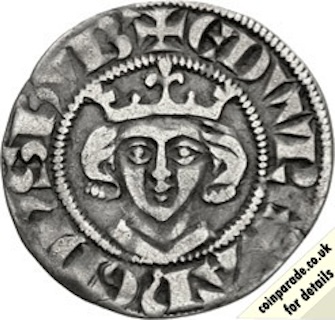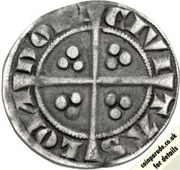
 The 1279 Penny - Edward I
The 1279 Penny - Edward ISilver penny of Edward I. New coinage (see below), this coin is a mule of class 1a/1c. Struck at the Tower (London) Mint during May–December 1279. Diameter 18mm, weight 1.3g. North: 1010/1012. SCBC: 1380 and 1382 (mule).
The Obverse shows a Crowned bust facing.
 Reverse if a Long cross pattée with triple pellets in quarters.
Reverse if a Long cross pattée with triple pellets in quarters.Image credit: CNG Coins
Mintage: Rare
Minted at The Royal Mint
More information (monarch, year, mint, country, category) can be found below coin listings.
Below are some coins currently being offered on eBay. As an eBay Partner, We may be compensated if you make a purchase.
List items on:
List items on:
Edward I (1272-1307)
Classification: Plantagenet King of England. Hammered.Edward was born in June 1239 at the Palace of Westminster, London, first son of Henry III of England and Eleanor of Provence. As a boy he was know as The Lord Edward. He became King on 12 November 1272, known as Hammer of the Scots and Edward Longshanks (as he was 6 feet two inches, which was very tall at that time). He died on 7 July 1307 (aged 68).
The coins of Edward I can be divided in two periods. 1272-1279 was the continuation of the Long Cross Coinage, where all the coins carried the name of Henry III. In 1279, Edward produced 'new coinage' that featured his name and also introduced the halfpenny, farthing and a four pence coin called a 'Groat'.
Category: Penny
The Penny is one of the most famous British coins. The coin itself has been around since 600AD and at various times has been struck in silver, copper and bronze. Originally split into halfpennies and farthing, it is now itself the least denomination coin currently in circulation. Made from copper (actually copper plated steel). Originally there were 12 pennies in one shilling and 240 pennies in £1; since decimalisation in 1971 there are 100 new pence in one pound.
Composition: Early pennies were Silver, then Copper, Bronze and Copper coated steel.
Which Mint: The Royal Mint
The Royal Mint is the designated place for the UK to mint coins. It dates back well over 1000 years and is a Government-owned company. Formed in the reign of Alfred the Great about the year 886, during the period 1279-1812 it was generally referred to as The Tower Mint as it was housed at the Tower of London. The Master of The Royal Mint has included famous figures such as Sir Isaac Newton.
Since 2010 it has operated as Royal Mint Ltd, a company owned by HM Treasury, under an exclusive contract to supply all coinage for the UK although it also produces medals and coins for other countries. It is currently located at Llantrisant, Wales.
Country of Origin: United Kingdom
The United Kingdom (UK) is the Union of England, Scotland, Wales and Northern Ireland. It is often refered to as Great Britain (GBR). It has a long, rich history. The orignal coinage was Pounds, Shillings and Pence but since decimalisation on 15 February 1971, it is £1 = 100p, that is One Pound = 100 pence. The coinage of the UK is also a long history, the Royal Mint being established as long ago as 886AD when coins were hammered. Today there is perhaps 30 billion coins in circulation, and many (numismatic) collectors coins and sets are issued frequently in gold, silver and other metals.








